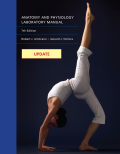
Don't go to the lab without it! With coverage of every structure and functionof the human body, the ANATOMY AND PHYSIOLOGY LABORATORY MANUAL, provides youwith the tools you need to succeed in this course. Lists of terms, diagrams of lab equipment, lab report questions, and report templates found in the manual help you easily and successfully complete your lab experiments and write-up your lab reports. INDICE: Laboratory Safety. Commonly Used Laboratory Equipment Pronunciation Key. Exercise 1 - MICROSCOPY. A. Compound Light Microscope. Exercise 2 - INTRODUCTION TO THE HUMAN BODY. A. Anatomy and Physiology. B. Levels of Body Organization. C. Systems of the Body. D. Life Processes. E. Homeostasis. F. Anatomical Position and Regional Names. G. External Features of the Body. H. Directional Terms. I. Planes of the Body. J. Body Cavities. K. Abdominopelvic Regions. L. Abdominopelvic Quadrants. M. Dissection of White Rat. Exercise 3 - CELLS.A. Cell Parts. B. Organelles. C. Diversity of Cells. D. Movement of Substances Across and Through Plasma Membranes. E. Extracellular Materials. F. Cell Division. Exercise 4 - TISSUES. A. Epithelial Tissue. B. Connective Tissue. C. Membranes. Exercise 5 - INTEGUMENTARY SYSTEM. A. Skin. B. Hair. C. Glands. D. Nails. E. Homeostasis of Body Temperature. Exercise 6 - BONE TISSUE. A. Functions of Bone. B. Structure of a Long Bone. C. Histology of Bone. D. Chemistry of Bone. E. Bone Formation: Ossification. F. Bone Growth. G. Fractures. H. Types of Bones. I. Bone Surface Markings. Exercise 7 - BONES. A. Bones of Adult Skull. B. Sutures of Skull. C. Fontanels of Skull. D. Paranasal Sinuses of Skull. E. Vertebral Column. F. Vertebrae. G. Sternum and Ribs. H. Pectoral (Shoulder)Girdles. I. Upper Limbs. J. Pelvic (Hip) Girdle. K. Lower Limbs. L. Articulated Skeleton. Exercise 8 - JOINTS. A. Kinds of Joints. B. Fibrous Joints. C. Cartilaginous Joints. D. Synovial Joints. E. Knee Joint. Exercise 9 - MUSCULAR TISSUE. A. Types of Muscular Tissue. B. Structure of Skeletal Muscle Tissue. C.Contraction of Skeletal Muscle Tissue. D. Laboratory Tests on Skeletal MuscleContraction. E. Biochemistry of Skeletal Muscle Contraction. F. Electromyography. G. Cardiac Muscle Tissue. H. Smooth Muscle Tissue. Exercise 10 - MUSCULARSYSTEM. A. How Skeletal Muscles Produce Movement. B. Arrangement of Fascicles. C. Naming Skeletal Muscles. D. Connective Tissue Components. E. Principal Skeletal Muscles. F. Composite Muscular System. Exercise 11 - SURFACE ANATOMY. A. Head. B. Neck. C. Trunk. D. Upper Limb (Extremity). E. Lower Limb (Extremity). Exercise 12 - NERVOUS TISSUE. A. Nervous System Divisions. B. Histology of Nervous Tissue. C. Histology of Neuroglia. D. Neuronal Circuits. E. Reflex Arc. F. Demonstration of Reflex Arc. Exercise 13 - NERVOUS SYSTEM. A. Spinal Cordand Spinal Nerves. B. Brain. C. Cranial Nerves: Names and Components. D. Tests of Cranial Nerve Function. E. Dissection of Sheep Brain. F. Autonomic Nervous System. Exercise 14 - SENSORY RECEPTORS AND SENSORY AND MOTOR PATHWAYS. A. Characteristics of Sensations. B. Classification of Receptors. C. Receptors forSomatic Senses. D. Tests for Somatic Senses. E. Somatic Sensory Pathways. F. Olfaction. G. Gustation. H. Vision. I. Hearing and Equilibrium. J. Sensory-Motor Integration. K. Somatic Motor Pathways. Exercise 15 - ENDOCRINE SYSTEM. A. Endocrine Glands. B. Pituitary Gland (Hypophysis). C. Thyroid Gland. D. Parathyroid Glands. E. Adrenal (Suprarenal) Glands. F. Pancreatic Islets. G. Testes.H. Ovaries. I. Pineal Gland. J. Thymus Gland. K. Other Endocrine Tissues. Exercise 16 - BLOOD. A. Components and Origin of Blood. B. Plasma. C. Red Blood Cells. D. Red Blood Cell Tests. E. White Blood Cells. F. White Blood Cell Tests. G. Platelets. H. Drawings of Blood Cells. I. Blood Grouping (Typing). Exercise 17 - HEART. A. Location and Surface Projection of Heart. B. Pericardium. C.Heart Wall. D. Chambers and Great Vessels of Heart. E. Valves of Heart. F. Blood Supply of Heart. G. Dissection of Sheep Heart. Exercise 18 - BLOOD VESSELS. A. Arteries and Arterioles. B. Capillaries. C. Venules and Veins. D. Circulatory Routes. E. Blood Vessel Exercise. Exercise 19 - CARDIOVASCULAR PHYSIOLOGY. A. Cardiac Conduction System and Electrocardiogram (ECG or EKG). B. Cardiac Cycle. C. Cardiac Cycle Experiments. D. Heart Sounds. E. Pulse Rate. F. Blood Pressure (Auscultation Method). Exercise 20 - LYMPHATIC AND IMMUNE SYSTEM. A. Lymphatic Vessels. B. Lymphatic Tissues. C. Lymph Circulation. Exercise 21 - RESPIRATORY SYSTEM. A. Organs of the Respiratory System. B. Dissection of SheepPluck. C. Laboratory Tests on Respiration. D. Laboratory Tests Combining Respiratory and Cardiovascular Interactions. Exercise 22 - DIGESTIVE SYSTEM. A. General Organization of Digestive System. B. Organs of Digestive System. C. Deglutition. D. Chemistry of Digestion. Exercise 23 - URINARY SYSTEM. A. Organs ofUrinary System. B. Dissection of Sheep (or Pig) Kidney. C. Urine. D. Urinalysis. Exercise 24 - pH AND ACID-BASE BALANCE. A. The Concept of pH. B. MeasuringpH. C. Acid-Base Balance. D. Acid-Base Imbalances. Exercise 25 - REPRODUCTIVESYSTEMS. A. Organs of Male Reproductive System. B. Organs of Female Reproductive System. C. Dissection of Fetus-Containing Pig Uterus. Exercise 26 - DEVELOPMENT. A. Spermatogenesis. B. Oogenesis. C. Embyronic Period. D. Fetal Period.Exercise 27 - GENETICS. A. Genotype and Phenotype. B. Punnett Squares. C. SexInheritance. D. Sex-Linked Inheritance. E. Mendelian Laws. F. Multiple Alleles. G. Genetics Exercises. Appendix A: Some Important Units of Measurement. Appendix B: Periodic Table of the Elements. Appendix C: Eponyms Used in This Laboratory Manual 629.
- ISBN: 978-1-133-36548-8
- Editorial: Brooks/Cole
- Encuadernacion: Desconocida
- Páginas: 250
- Fecha Publicación: 12/02/2012
- Nº Volúmenes: 1
- Idioma: Inglés
